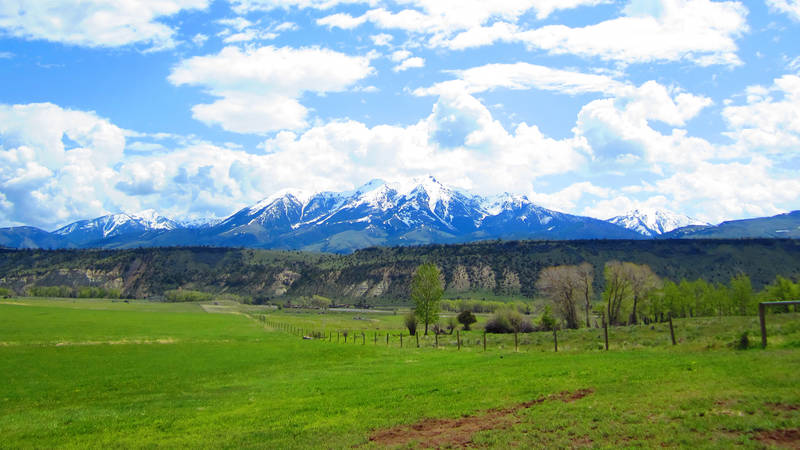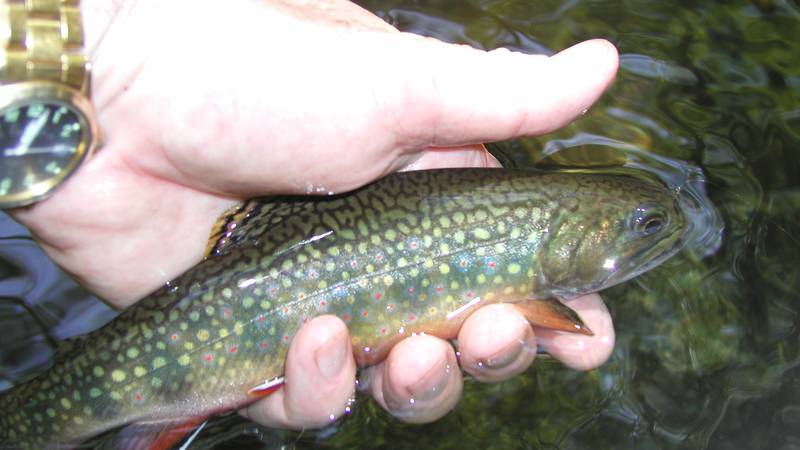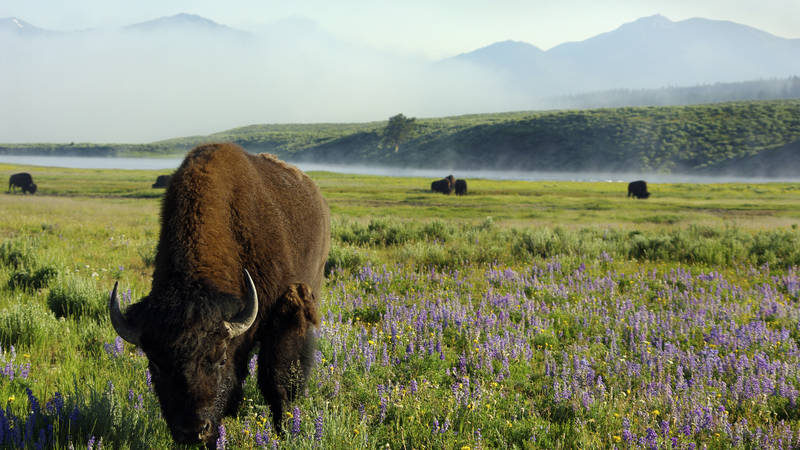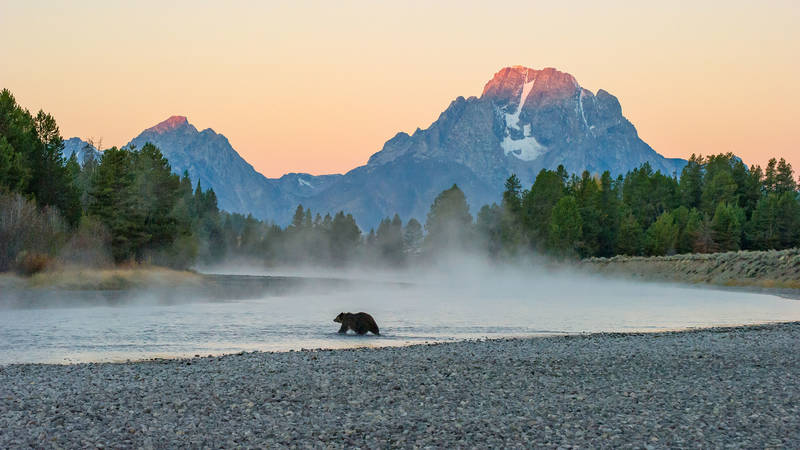NPCA has named a new wildlife program director to strategically coordinate its many campaigns across the country and ensure the long-term conservation of park wildlife. Veteran park defender Bart Melton speaks to his new role, some of the serious threats that park wildlife face, and NPCA’s priorities to help park wildlife thrive.
What is your experience working on wildlife issues at NPCA?
I’ve been with NPCA for about 13 years now. I started in the Southeast, did a stint in our D.C. office focused on large-landscape conservation, and most recently served as the director of our Northern Rockies Region. Starting out in the Southeast, much of my work focused on protecting the Big South Fork National River from upstream mountaintop removal mining. Coal mining was a major threat to aquatic species in the Big South Fork, which is a hotspot globally for endangered mussels. That was my first exposure to working on species-specific issues.
During my time in the Southeast, I also supported NPCA’s work to clean up coal-fired power plants. These plants have been a major source of mercury pollution, as well as sulfur dioxide, which can lead to acid rain — both pollutants pose major issues for wildlife. In the case of the Great Smoky Mountains, mercury and acid rain were seriously harming a unique cold-water fishery for native trout and salamander populations.
People don’t normally think of coal-fired power plants as a wildlife issue.

Yellowstone Is Worth More Than Gold
Interior Secretary Ryan Zinke signs 20-year mineral withdrawal that will prevent new mining north of the national park.
See more ›That’s right. Sometimes the threats to wildlife aren’t straightforward. Many times, it’s what’s happening or proposed beyond park borders that’s threatening the species that make national parks unique. It could be a solar facility next to Mojave National Preserve in California that would have harmed bighorn sheep migrations or industrial-scale gold mines near Yellowstone that were proposed in core habitat for the Yellowstone grizzly. In both these cases, inappropriately sited facilities threatened to degrade habitat and migration routes outside park boundaries that national park wildlife depend on.
What were you focused on during your last stint in NPCA’s D.C. office?
In D.C., I focused much of my time on advocating for policies to protect national parks from climate change. Climate change is a critical issue of concern for park wildlife because it is altering the habitat, food and water they depend on faster than they can adapt. Park ecosystems are changing rapidly as a result of increased greenhouse gas pollution. A recent study showed that national parks are warming at twice the rate of other areas in the U.S. As parks become warmer and drier, as snowpack declines and glaciers melt, wildlife move in different ways across the landscape. So the question becomes, how do park managers and policymakers react?

Do Brook Trout Have a Future in Shenandoah?
One of Virginia’s most popular national parks is a haven for native fish, but warming waters could prove devastating for this keystone species.
See more ›Of course, first and foremost, we have to stop creating more greenhouse gases! But climate change is already happening and will get worse before it gets better, so we also need to do whatever we can now to help wildlife adapt to these changes. Protecting wildlife migration corridors, increasing scientific research dollars, and incentivizing collaborative management between federal agencies, state agencies and local community members will all help give wildlife a fighting chance in the face of climate change.
I also helped launch NPCA’s campaign addressing the impacts of oil and gas development on park ecosystems. In places like Wyoming, energy development and wildlife needs can come into conflict. Pronghorn antelope, mule deer and elk seasonal migration corridors can extend hundreds of miles beyond the borders of Grand Teton and Yellowstone National Parks. One oil well sited in the wrong spot can permanently block or destroy a corridor that has existed for hundreds of years. This continues to be a problem in parks across the West. NPCA’s oil and gas team is working to address this and other issues associated with ever-expanding drilling on federally owned lands adjacent to parks.
You most recently worked for NPCA in Montana. How long were you there?
I was there for about six years, two years as Yellowstone program manager and about four years as Northern Rockies regional director. My team was deeply involved in a number of wildlife campaigns. For example, due to an outdated policy, every year hundreds of Yellowstone bison are captured and shipped to slaughter even though more conservation-minded options exist. In recent years, NPCA and our partners have been able to advance some commonsense solutions to this outdated policy. In 2016, the governor of Montana approved 330,000 acres of new habitat for bison on federal lands beyond park borders. This year, a few bison are being moved to a tribal conservation herd rather than being shipped to slaughter. However, much work remains to be done to ensure the long-term conservation of the Yellowstone’s bison.

Yellowstone Bison Find Year-Round Room to Roam in Montana
This will be the first time in generations that bison will be granted year-round #RoomToRoam
See more ›Working to protect Yellowstone’s bison and on other wildlife issues offered me hands-on experience in the Northern Rockies that I hope to carry into my new role.
Although wildlife in national parks is of national importance, once park wildlife migrates beyond park borders the management decisions affecting their future are made by state and local decision-makers. It was an important experience for me to spend my time getting to know community members in the Northern Rockies, including ranchers, tribal members and other folks who are helping shape the future for bison, grizzly bears, wolves and other park wildlife. It’s really important that we figure out how to allow wildlife populations to thrive while also addressing the needs of the people who live in communities near parks.
You capped off your time in the Northern Rockies with a major victory, stopping a grizzly bear hunt in Wyoming.
The team had a few great victories. The grizzly bear was listed as threatened in 1975. Since then, millions of taxpayer dollars have been invested to bring the Yellowstone population back from the brink of extinction. Slowly, as a result of the dollars invested and dedicated state and federal scientists working on the ground, the health of the population has improved, but much work remains to be done to ensure the long-term conservation of the species.

Grizzlies Saved: Court Stops Trophy Hunt of Yellowstone’s Iconic Bears
Judge rules that the Trump Administration unlawfully removed federal protections for Greater Yellowstone Ecosystem grizzly bears.
See more ›The habitat for the bear includes Yellowstone National Park and millions of acres of adjacent habitat. When bears are ready for delisting, management of the bear beyond Yellowstone will be turned over to the states of Montana, Wyoming and Idaho. Roughly two years ago, the US Fish and Wildlife Service proposed removing the bear from the Endangered Species List. In reaction to the decision potentially being finalized last fall, the states of Idaho and Wyoming proposed opening trophy hunting for 23 grizzlies just across the borders of Yellowstone and Grand Teton.
After much analysis and consideration, NPCA decided the Yellowstone grizzly isn’t ready to have Endangered Species Act protections lifted or lose a significant number of bears to hunting. We joined our partners challenging the removal of Endangered Species Act protections in court and rallied the public to oppose the proposed trophy hunts.
Our coalition was successful in court, and for now, the Yellowstone grizzly will remain on the endangered species list and no trophy hunting will be allowed. However, there is a distinct possibility that the Department of the Interior will file an appeal to the judge’s decision. So, it’s likely the fight to protect the Yellowstone grizzly will continue.
What are your priorities moving forward?
NPCA has been working on wildlife issues for 100 years, so we have a long list of victories. But national park wildlife face many challenges today. NPCA’s 100th anniversary this year is an opportunity for us to recommit to this work for our next 100 years.
We will be working to establish a program that supports on-the-ground species conservation and also works to address large-scale, systemic threats like habitat destruction, unsustainable management and climate change. This means we will focus on park-specific wildlife conservation projects, like our work at Yellowstone to protect grizzlies and bison, while simultaneously ensuring strong federal protections and policies are in place, such as those provided by the Endangered Species Act.
Park wildlife face serious threats. It’s imperative that we’re better organized than ever to face those challenges. NPCA staff around the country have a long list of ongoing fights and victories, and I feel pretty darn lucky to get to work with such dedicated people.
About the author
-
 Jennifer Errick Managing Editor of Online Communications
Jennifer Errick Managing Editor of Online CommunicationsJennifer co-produces NPCA's podcast, The Secret Lives of Parks, and writes and edits a wide variety of online content. She has won multiple awards for her audio storytelling.
-
Issues


